-
Posts
14,343 -
Joined
-
Last visited
-
Days Won
25
Content Type
Profiles
Forums
Blogs
Gallery
Events
Store
Posts posted by Ed_Haynes
-
-
Dost Kumal, Bengal Sappers and Miners
Ghazni Medal, 1839 -- For the defence of Ghazni, 21-23 July 1839. Originally an Afghan award, but after the fall of Amir Dost Muhammad it was "Adopted" by the East India Company. The Queen had extended her permission for Crown troops to wear the Afghan medal in March 1841. In accuracy, it should probably be treated as an Afghan medal, though its status is ambiguous.
The 2nd and 3rd companies of Bengal Sappers and Miners served in the Bengal Column, under Maj-Gen. Sir W. Cotton.

 0
0 -
Khan Sahib Arbab Mohd Ayub Khan. Deputy Superintendent of Police, Punjab
Indian Police Medal, George VI, for distinguished conduct
Gazette of India, 2 January 1939:
"Khan Sahib Arbab Mohd Ayub Khan is an Afghan of the Peshawar district. He joined the Police as a Probationary Sub. Inspector in 1909 and held non-gazetted appointments until February 1919, when he was appointed to officiate as Deputy Superintendent of Police. He was confirmed in this rank in February 1923. He was commended on numerous occasions during his non-gazetted period of service, and in January 1930, he was awarded the title of Khan Sahib. During the course of his 29 years served, this officer has shown himself to be possessed of strength of character and ability above the average, and has maintained an excellent reputation for integrity and impartiality. In February 1938 the communal relations in the Kaithal sub-division, Karnal district, became seriously strained over the question of kine slaughter. In one village over 1,000 Hindu Jats collected to prevent kine slaughter on the occasion of Id. Mohammedans also collected and a very threatening situation arose. It was entirely owing to the tact courage and resource displayed by Khan Sahib Arbab Mohd Ayub Khan that the outbreak of a serious riot was prevented. His energetic action was all the more creditable in view of the fact that he is 52 years of age."

 0
0 -
Burma Gallantry Medal
Named: 61314 A/HAVILDAR-MAJOR SA BAW GAM. THE BURMA REGT.
Kachin, from village Jakhandap, district Bhamo.
London Gazette, 19 July 1945, p. 3719, "in the field": "No. 61314, Havildar-Major (acting) Sa Baw Gam, The Burma Regiment"
Citation, from WO 373/98/487:
"During the period October 1942 to April 1944, this soldier carried out many months continuous and volunteer patrolling in Japanese occupied territory as much as 150 miles in advance of our troops. For six months he was senior NCO of the patrol, and owing to his knowledge of Burmese was the one mainly employed in plain clothes for contacting villagers. Working in conditions of extreme physical and nervous strain, he carried out these duties even when the patrol was being closely pursued and he was under nervous tension amounting almost to terror. He was one of the patrol which was accompanied to INDAW in November 1943 by an R.E. Lt.Colonel (who was awarded an immediate D.S.O. for the visit) and which stayed on patrol around that area for 4 months after the Lt.Col.'s returnm to the British lines."
According to other information with the medal (apparently from an interview with his wife?), he escaped from Burma by boat in August 1942, being at sea with no food for eight days before reaching Calcutta. He was there enlisted in (Z) Force and received gas, parachute, and intelligence training. He returned to Burma on several occasions (sometimes by parachute) and worked behind Japanese lines. After WWII he joined the 3rd Kachin Rifles and rose to the rank of 2/Lt. He retired and died in February 1992.
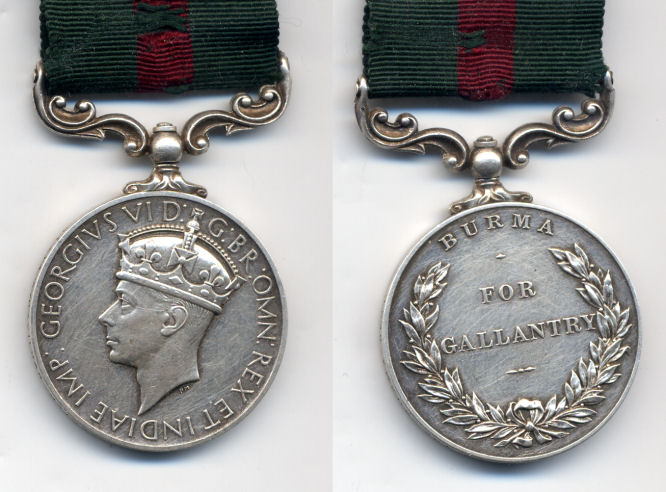
 0
0 -
467 Naik Basawa Singh. No. 2 (Derajat) Mountain Battery, P.F.F.
Central Africa Medal, 1891-98 "CENTRAL AFRICA 1894-98" - 467 Naick Basawa Singh. No. 2 Batty.
The 2nd MB claimed 5 medals, he was the senior NCO present. For 14 separate expeditions, January 1894-April 1898. He served: (1) Matapauiri, September 1895; (2) the expedition against Chikusi, October 1896; and (3) the expedition against Chief Mpeseni of the Chimpingo, January-February 1898.
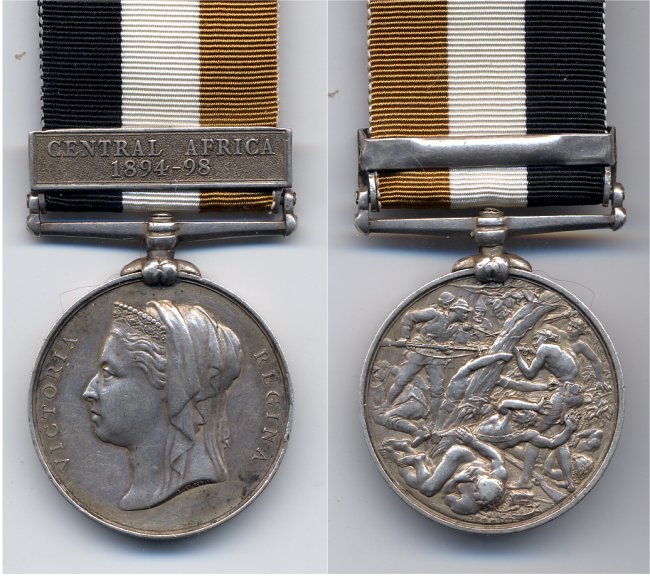
 0
0 -
Muleteer Chundiah Singh, 3rd Levy Punjab Muleteers
Abyssinian War Medal, 1869 - Muleteer Chundiah Sing 3rd Levy P Muleteers
Sent out to Ethiopia: 8 Jemadars, 7 Daffadars, 403 Drivers, 1 Mate. Somehow, there had been confusion and theh mule drivers had gotten the idea they were to be combat troops and there was a near mutiny once they reached Ethiopia.
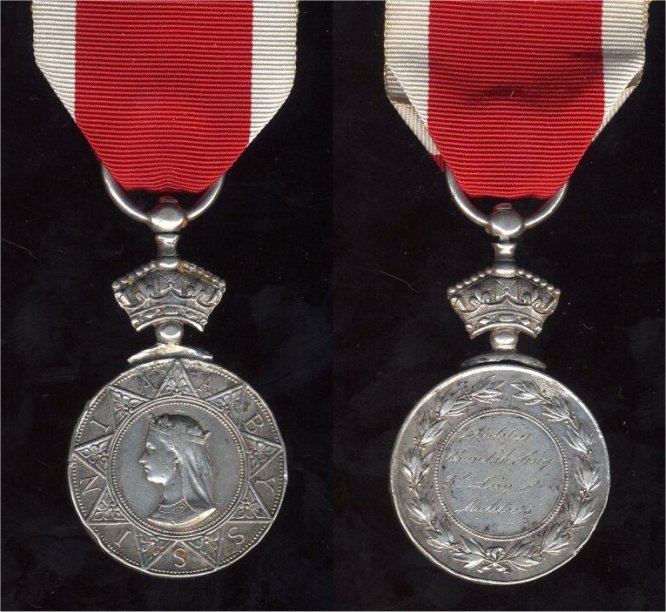
 0
0 -
Sepoy Hanuman Singh, 50th Bengal Native Infantry
Punniar Star, 1843 - Sepoy Hunnoommun Sing, 50th Native Infy.
Raised in 1804; mutinied at Nagode, 27 August 1857.

 0
0 -
I guess I could put these in a "collector's showcase", but I have started here already. Please, others add on.
I will show a few, and can show more as interest demands. Won't show ones I have shown elsewhere
0 -
And many of the IMD were Anglo-Indian ("Eurasian").
0 -
Could you explain the Indian titles? I see there are Hindu and Muslim, but what is the exact scale and what would "equivalents" be--
Babu, for instance was a Lowly Sort not deemed of "officer" status, and the persistent references to salaries leads me to think these civil titles somehow equate to what would be a military rank, in the way that a German "Assessor" was a "Hauptmann" and an "Oberregierungsrat" was an "Oberstleutnant" for dinner seating purposes.
Ah . . . titles. You'll be sorry you asked. To put it very briefly (really):
Things like "Babu" were merely titles of respect (= "Mr.) but with a Bengali regional connotation and, over time, becoming a title of ridicule.
Arguably, the title badges are one of the least understood but most interesting of pre-1947 British awards for India.
Titles had been awarded since before even Sultanate and Mughal times and remained (and remain) one of the important indigenous means of recognizing achievement. As the East India Company emerged as one of the regional power players in the Subcontinent by the early 18th century, they, too, became both the recipient and bestower of titles. By the early 19th century, they moved to eclipse the Mughal Emperor in all aspects of his power, including the right to award titles. This practice continued and grew even into the years after 1858, when India came under vaguely defined crown rule. Yet the patterns of awarding titles remained a distinctly provincial and regional activity and there was no central "system" until efforts began in the late 1880s at standardizing and rationalizing the award of titles.
At the suggestion of Maharaja Ganga Singh of Bikaner, and as one of the "Durbar Boons" for the 1911 Durbar, the king-emperor established a series of accompanying "badges" which could be worn to display the title awarded. Restospective badges were awarded for those individuals still living who had received titles prior to 1911 and the titles awarded at the Durbar and afterward were accompanied not only by the customary sanad (certificate) but by a badge.
Roughly, these titles were awarded in three "degrees", with distinctive titles representing the imperial construction of religion and region in India.
1- A silver-gilt six-pointed rayed star (the gilt is very thin and has often disappeared in polishing or simply evaoprated over time) with a crown above and the image of the king-emperor in the center (facing to the viewer's right). The name of the title is on a light blue enameled circlet surrounding the king's image. The ribbon is light blue ("Star of India" blue) with narrow dark blue ("Order of the Indian Empire" blue) edges. The badges were worn around the neck from a 45-inch length of ribbon. All badges, including the restrospective awards, were named on the reverse.
1a- "Sardar Badadur" to Muslims (almost uniquely in Baluchistan and Sind) and to Sikhs (in the Punjab only) - Almost all "Sardar Bahadur" awards were to Sikhs or to individuals with significant military service. Great confusion accompanied the fact that the title "Sardar Bahadur" was also awarded with the OBI 1st class.
1b- "Diwan Bahadur" to Hindus (in practice, mostly in southern India)
2- As for the "1st class", but with the encircling band unenameled (the intent was for it to be red enamelled, but the mint could find no red enamel that would stick to the medal and green was not deemed appropriate due to to religions connotations regarding Islam). The ribbon is light red with narrow darker red edges.
2a- "Khan Bahadur" - to Muslims
2b- "Rai Bahadur" to Hindus in "north India"
2c- "Rao Bahadur" to Hindus in "south India"
3- As for the 1st and 2nd class, but all silver. The encircling band with the name of the title is enameled in dark blue. The ribbon is dark blue ("Order of the Indian Empire" blue) with narrow light blue ("Star of India" blue) edges.
3a- "Khan Sahib" - to Muslims
3b- "Sardar Sahib" - to Sikhs, usually in Punjab only (elsewhere, they were rewarded as Hindus)
3c- "Rai Sahibr" to Hindus in "north India"
3d- "Rao Sahib" to Hindus in "south India"
Neither the geographical distinction between ?Rais? and ?Raos? nor the dividing line between the great defining category of ?British India? ? religion ? was entirely impermeable. In general, the ?Rai? title was awarded to Hindus in north India (Bengal, East Bengal, Assam, Burma, the United Provinces, Punjab, the North-West Frontier, and Baluchistan), while the ?Rao? titles were awarded to Hindus in Madras and Bombay (including Gujarat). Other areas were more ambiguous, and ?Rai? and ?Rao? titles were bestowed in almost equal numbers in the Central Provinces and Central India, in Hyderabad, in Mysore, and in Rajputana and Ajmer-Merwara; in many cases, nominated title recipients were consulted as to their personal preference between the ?Rai? and ?Rao? appellations.
Religious distinctions, however certain they sometimes appeared in the census process, were an especially complex problem. In general, Hindus were ?Hindus? and Muslims were ?Muslims". In general, Parsis (Zoroastrians) were treated as ?honorary Muslims? and received the standard Khan Sahib-Khan Bahadur-Sardar Bahadur progression of honorifics. There were, however, cases of Parsis being appointed in the ?Hindu series? of titles. Sikhs posed a particular problem, occupying as they did both a prominent position in the ?Martial Races? ideology of ?British India? and an ambiguous religious niche between Hinduism and Islam. This difficulty was, of course, compounded by late-nineteenth-century movements within the Sikh community that aimed as asserting an increasingly distinct religions identity. As these movements progressed throughout the early twentieth century, they would generate greater problems in India than just what title to award deserving Sikhs. Yet, in the realm of titles, most provinces treated Sikhs as Hindus and awarded them the ?Hindu series? of titles. Only the Punjab government ? and this is hardly surprising ? adopted a different policy, and had been awarding the title of ?Sardar Sahib? to Sikhs at the lowest level of achievement and, apparently, promoting Sardar Sabibs direct to ?Sardar Bahadur? as their next step in the title hierarchy, by-passing the normal second-level titles entirely. Jews were rewarded as Muslims and Christians were awarded titles approroitate to what their families had been prior to conversion (if it could not be determined, they, too, were seen as honorary Muslims). Buddhists were rewarded as Hindus. As no titles have been located that were bestowed on Jains, it is impossible to determine how they were fitted into the title regulatory policies. Anglo-Indians ("Eurasians") and women were never included in the title badge system.
Appointments, except in truly exceptional cases, would be to the lowest level (for example, a Hindu (in Bengal) would first be made a ?Rai Sahib?), and later appointments would come to the intermediate (?Rai Bahadur?) and highest (?Dewan Bahadur?) titles. In practice, most Muslims were restricted to two "steps": "Khan Sahib" to "Khan Bahadur". A Sikh, however, would vault from "Sardar Sahib" to "Sardar Bahadur".
From 1913, the date of the award of the title (usually, but not always, either New Year's or Birthday Honours) was added to the naming engraved on the reverse. (Unnamed badges are mint "espcapees".)
After WWI, miniature medals came into fashion and a place had to be found in the order of wearing for the title badges. They were inserted following the Kaisar-i-Hind Medals, a rather lofty place (a fact not widely known, then or now). An ongoing debate raged as to whether the badges could be worn either in uniform or in ribbon bars. It had been the original intent to restrict their wearing, but over time this policy erroded. An additional problem arose (one that can be comprehended by those who collect these badges today) in that the ribbons were difficult to obtain, especially in the lengths required. The ribbons were made in China and, with the rise of civil war, supplies were difficult. As a response to this problem, in part, the badges were allowed to be worn on the left breast, if the recipient so desired, from 5 March 1923.
On 1 June 1933, the awareness seems to have dawned that the image of the King-Emperor on the title badges was facing in the ?wrong? direction, and the king?s image was reversed to face, more properly, to the left (as seen by the observer). While design work was begun for Edward VIII badges after the death of George V, this work was stopped when he abdicated in favour of his brother. The massive confusion of this period led to the issue of interim badges for the 11 May 1937 (Birthday Honours) awards where an interim image of the new ruler, George VI, was simply glued over the old image of his father, which had been ground down. Even honor could become flexible when demands of schedules and costs demanded. The award of title badges continued until the final honours lists to Indians, 13 June 1946.
To summarize:
100 George V (first type, bust right, undated 1911-13):
110 1st class:
111 Sardar Bahadur
112 Diwan Bahadur
120 2nd class:
121 Khan Bahadur
122 Rai Bahadur
123 Rao Bahadur
130 3rd class:
131 Khan Sahib
132 Sardar Sahib
133 Rai Sahib
134 Rao Sahib
200 George V - first type, bust right, dated, could be worn on breast ribbon from 1923 (1913-33):
210 1st class:
211 Sardar Bahadur
212 Diwan Bahadur
220 2nd class:
221 Khan Bahadur
222 Rai Bahadur
223 Rao Bahadur
230 3rd class:
231 Khan Sahib
232 Sardar Sahib
233 Rai Sahib
234 Rao Sahib
300 George V (second type, bust left, 1933-37):
310 1st class:
311 Sardar Bahadur
312 Diwan Bahadur
320 2nd class:
321 Khan Bahadur
322 Rai Bahadur
323 Rao Bahadur
330 3rd class:
331 Khan Sahib
332 Sardar Sahib
333 Rai Sahib
334 Rao Sahib
400 George VI - interim "pasted-on" awards (11 May 1937):
410 1st class:
411 Sardar Bahadur
412 Diwan Bahadur
420 2nd class:
421 Khan Bahadur
422 Rai Bahadur
423 Rao Bahadur
430 3rd class:
431 Khan Sahib
432 Sardar Sahib
433 Rai Sahib
434 Rao Sahib
500 George VI (1938-47):
510 1st class:
511 Sardar Bahadur
512 Diwan Bahadur
520 2nd class:
521 Khan Bahadur
522 Rai Bahadur
523 Rao Bahadur
530 3rd class:
531 Khan Sahib
532 Sardar Sahib
533 Rai Sahib
534 Rao Sahib
There was also a separate series of titles (and badges) for literary titles and for titles awarded in Burms, but these are another topic, for another day.
For more, if you can stand it, see: http://sagongs.ipbhost.com/index.php?showtopic=265
0 -
885 Sowar Naurang Singh, Patiala Imperial Service Lancers
1- Queen's South Africa - CAPE COLONY, ORANGE FREE STATE, TRANSVAAL - 885 SOWAR NAURANG SINGH. PATIALA LCRS.
2- King's South Africa - SA 01, SA 02 - 885 SOWAR NAURANG SINGH. PATIALA LCRS.
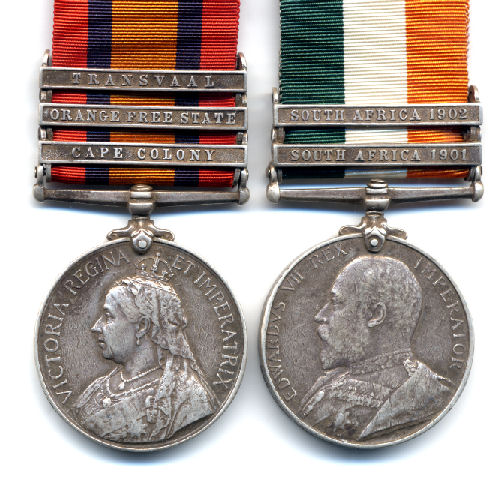
 0
0 -
2208 Sepoy Hardit Singh, 31st Bengal Infantry
1- Central Africa Medal - "2208 Sepoy Hardit Singh, 31st Bl Infy"
2- India Medal 1895 - PUNJAB FRONTIER 1897-98, MALAKAND 1897 - "2208 Sepoy Hardit Singh, 31st Bl Infy"
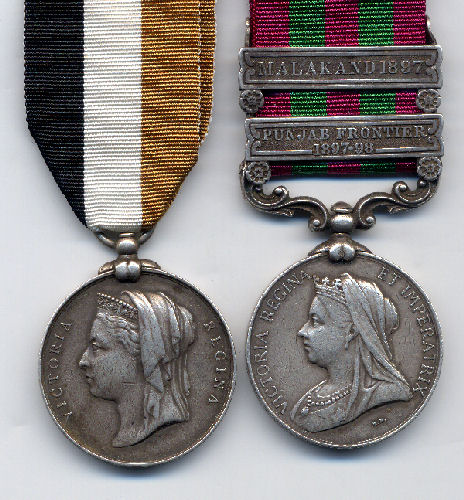
 0
0 -
Sepoy Nehala 20th Punjab Infantry
1- India General Service Medal 1854 - JOWAKI 1877-8 - "Sepoy Nehala 20th Regt N. I."
2- Second Afghan War- ALI MUSJID - "Sepoy Nehala (1) 20th Regt N. I."
3- Egypt 1882 - "Sepoy Nehala 20th Punjab Infy"
4- Egypt: Khedive's Star, 1882 - unnamed

 0
0 -
But the problem (?) with these tricky Britoish gongs is that not only are they all unique (= named), but that you never know what story lurks behind the metal and cloth.
Case in Point: A simple (enough) Khan Bahadur badge to Abdul Rauf Khan - unknown person.
Then comes his IGS 95 on auction in London (for which I paid way too much). REUNIFICATION!!
Then the research. Wow!
See
http://gmic.co.uk/index.php?showtopic=2400&st=14
for a tale that will curl the hair on your furry hobbit feet.
0 -
See: http://gmic.co.uk/index.php?showtopic=3374
Too many parallel threads here, methinks?
0 -
Thanks much - time to start squinting . . . .
0 -
But, you know, guys, the new "CAB" is neither the stupidest or the ugliest contemporary US badge. As evidence, the Air Force "Historian" badge. Almost makes me ashamed of being a historian.
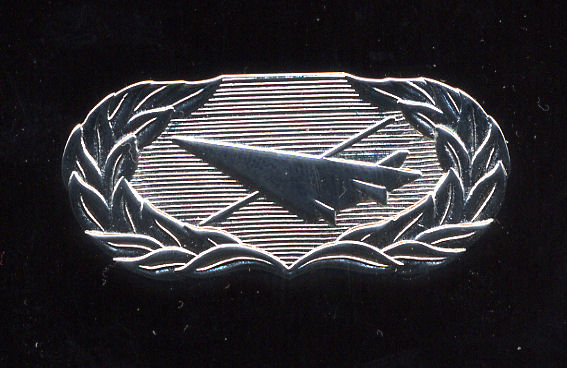
 0
0 -
Thanks, Christian. That is am IMMENSELY elusive one!
0 -
Medal "60 Years of Armed Forces of the MPR" (1921-81)
Battushig A.54, p. 71

 0
0 -
Medal "70 Years of the Mongolian People's Revolution" (1921-91)
Battushig A.55, p. 71

 0
0 -
Medal "60 Years of the Mongolian People's Republic" (1921-81)
Battushig A.53, p. 71
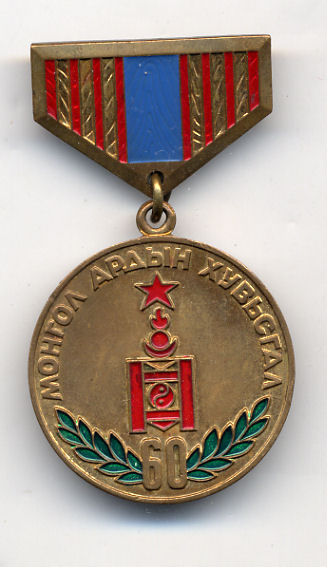
 0
0 -
Medal "50 Years of the Mongolian People's Revolution" (1921-71)
Battushig A.46, p. 69.
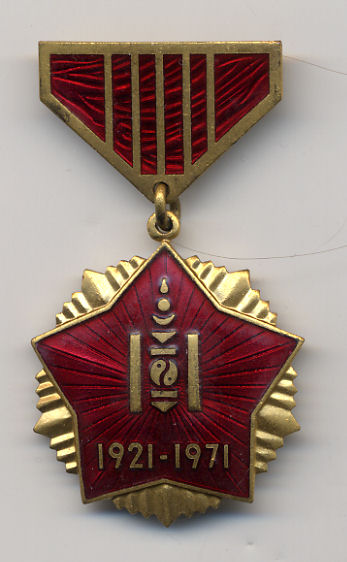
 0
0 -
None of the following items are especially rare but, in the spirit of inclusiveness, I thought we ought to have them up here.
Medal "40 Years of the MPR" (1921-61)
#22963
Battushig A.43, p. 68.
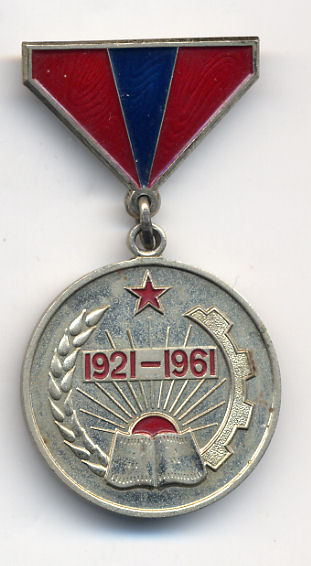
 0
0 -
Glad to see this forum. I neither collect nor know much about pre-Revolutionary Russian ODMs.
This is why I welcome the forum: to learn!
 0
0 -
Well, . . . .
The 1 Jan 1946 Indian States' Forces List shows but one Ahluwalia, a Major C. S. Ahluwalia, Bahawalpur Supply Department. There are no likely matches in Kapurthala or Patiala (the most likely places to look for him), but Ahluwalia is scarcely an uncommon name.
While there are lots of Alhuwalias in the Sept 1952 Indian Army List (the next data point I have), there's no "K.S.B."
I cannot imagine any post-1950 Indian Army officer wearing (lion badges of rank after 1950, crown 1947-50) a breast star of any sort. Cariappa did it just because he was Cariappa and thought he could flount even presidential orders. It would have been vaslty contrary to regulations and standards. Gen. Das got in enough trouble for wearing his O.B.E., even if he was not allowed to use the postnominals.
I can check full army lists at USI-I in December and ask H.H. Kapurthala, but I doubt your man is out of that family. Ultimately, there is no substitute for actually checking the records, even if the army lists are often flawed.
0




Pre-1947 Indian Single Medals
in Great Britain: Orders, Gallantry, Campaign Medals
Posted
Sowar Lachman Singh, Fane's Horse
Second China War Medal, 1857-60 - TAKU FORTS 1860, PEKIN 1860 - SOWAR LUTCHMAN SING, REGt of FANE'S HORSE.
Regiment raised for service overseas at the outbreak of the Second China War and was filled with volunteers, as was the custom for Indian units pressed to "cross the black water." Together with Probyn's Horse it stormed the Taku Forts in August 1859 and continued on to Peking, where it was in the van of the final cavalry attack that routed the Manchu and Mongol horsemen from the city, earning five Indian Orders of Merit for its more impressive members. (Of whom Lachman Singh was NOT one, alas.)